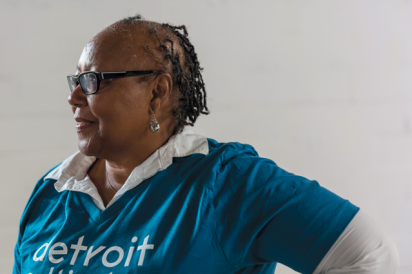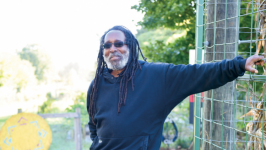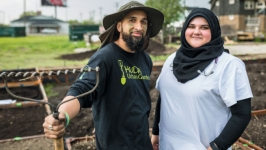Planting Seeds of North End’s Revitalization
Painted bright blue and yellow, the Oakland Avenue Urban Farm Community House stands out on Goodwin Street: a cheery, sunny spot against a wintry landscape on a gray day.
Inside, the house is bustling with activity. The chalkboard lists the names of fruits and vegetables— including greens, broccoli and watermelon— destined for planting. They’re not only prepping for the growing season, but also getting ready to expand the farm’s footprint to cover 5.5 acres in the North End neighborhood of Detroit.
This neighborhood, with its proximity to Midtown and New Center, has become one of the areas in the city primed for gentrification as businesses and people are displaced from the hot neighborhoods to the south. But just 10 years ago it was a different story.
Jerry Hebron sits at the table in the Community House and recalls when she returned to the neighborhood after her mother, Reverend Bertha L. Carter of St. John’s Evangelist Temple of Truth, asked her to come back. She lived there as a child and remembers a thriving neighborhood with nightlife, groceries, businesses, a rec center and elementary, middle and high schools. There was a sense of community, and people were really close.
“It was very densely populated,” she recalls. “I felt safe as a child. We could get anything we wanted inside the community ... that was my driving force, just thinking back, ‘What was this neighborhood like? How did it get to the state that it’s in?’ And then trying to work from that to see where we could take it.”
She moved to the northwest side when she was in her teens. But in 2008 everything went “upside down,” she says, and as a real estate broker the recession hit her especially hard. She had to close her offices.
Her mother had started feeding the homeless nearly 10 years before, paving the way for the founding of the nonprofit Northend Christian Community Development Corporation (CDC)—the farm’s parent organization—but Reverend Carter needed more help to serve the community more.
Through community engagement, Hebron quickly learned the three things that people in the neighborhood wanted. “We were told over and over again that food, jobs and housing [were needed]. We had no money for many, many years, so the only thing we could effectively do was build relationships and grow food.”
Initially the CDC wanted to activate 10 vacant lots, but that was too big so they started with a community garden on a 20- by 20-foot lot.
“It was hard at first trying to demonstrate to folks why they pay a little bit more here than the corner store, but they get it now,” Hebron says. “It’s simple because when you come to our vendor table, we’re able to take people right to where their food is grown.”
The next year the farm included a 60- by 60-foot lot with hoop houses. In 2011, they added the house that would become the Community House. Next on the agenda was creating jobs. But there was still no money.
“We didn’t have any money to pay people until the farmers’ market started, and we were able to get people to work cooperatively, so everything we grew and sold went into a pot, and then it was divided equally. We did that for several years,” Hebron says.
With support from outside organizations such as the Kellogg Foundation, the farm was able to cover operations and pay a better wage. Today, 18 Oakland Avenue Urban Farm workers earn $10–$12 an hour.
Hebron employs young people, who in addition to earning a paycheck, are taking pride in their neighborhood. “Sixteen-year-olds [in the neighborhood] have only seen decay. When people started talking about what this neighborhood was like, it changed their whole perspective.”
At the end of 2016, the farm landed a $500,000 grant from ArtPlace. “That opened up another opportunity for us to continue employment opportunities and to focus on our infrastructure work,” Hebron says. Now they’re raising $2.2 million to continue building out their 5.5 acres, which will include a library, a cultural learning lab, another hoop house, a food business incubator, a greenhouse and fruit trees.
The farm is also looking into housing and business development in the North End. The work they are doing is pushing back on gentrification, Hebron says. “We want to help keep people in their homes; we don’t want people to be displaced.”
It’s taken them 10 years to get to this point, and there’s still work to be done. When asked about how the North End now compares to 2008 when she came back, Hebron takes a sip of her hot tea and pauses before answering.
“Probably from your eyes you still see decay. I see different. Because one reason I see different is I’m a former real estate broker, so where people see decay I see opportunity.”
She saw it 10 years ago and continues to see what the neighborhood was and what it can be. And so do the residents of the North End.
Learn more at OaklandUrbanFarm










